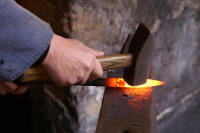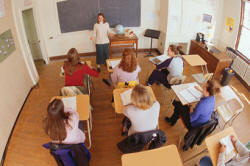Causative verbs and structures
 |
| Make it so |
Analyses of causatives in English are often confined to the causative verb structures with have and get as in, e.g.,
- I'm having the car serviced
- I'll get the car serviced
There is, in fact quite a lot more to it than that, as we shall see.
Here's the menu for this guide. Use it if you are looking for something in particular or just work through the guide as it comes.
Clicking on -top- at the end of each section will take you back to this menu.
 |
Cause and effect |
English has a number of ways to express the fact that the subject of a verb causes a change to the object. Here are some examples and they are all ways of saying something caused something to happen in English.
- The key opened the box
- They have widened the street
- Her antagonism irritated him
- The sun warmed the air
- The police marched the suspect in and stood him against the wall for a photograph
- She's walking the dog
- We liquefied the gas
Some of the causative verbs in these examples can be used
both transitively (taking an object) and intransitively (with no
object). We can have
The box opened (3)
The air
warmed (6)
The suspect marched in and stood against the wall
(7)
The dog is walking (8)
The gas liquefied (9).
When they are intransitive, they cannot, by definition, be
causative because causation directly implies an object.
In other cases, we can't do this and have to use an alternative
verb or rephrase the idea:
The street got wider
or
The street was widened (4)
and
He became irritated
or
He was irritated by her
antagonism (5).
When we use the passive (the second realisations), the sense of
causation is maintained because causative verbs like these may be used
in both active and passive voice clauses.
 |
Transitivity: English and other languages |
Other languages handle transitivity in very different ways. This matters because, by their nature, causative verbs are transitive.
In some, verbs may take what is called the ergative case, in which
the ostensible grammatical subject is semantically the object of the
verb, when used
intransitively and the verb and the noun (and adjective and article, often) will be
marked to show the case so those languages can produce
He irritated (to mean became irritated)
The dog walked (to mean
was walked)
The door opened
and so on. The last of these is an ergative clause in English
but the language does not signal case on any nouns or verbs so it is identical to an
active sentence. We have the same phenomenon operating with, e.g.:
The water boiled
The book sold well
The potatoes overcooked
The trousers tore
which are superficially illogical because we do not normally allow
inanimate subjects to do these things.
In other languages, such as Malay, a verb can be the same in both transitive and
intransitive uses but will take a suffix or other change to show whether
it is being used transitively or intransitively.
English does not vary the verb form but shows transitivity by word
order, structure or rephrasing with a different verb. For example,
I washed the car vs. The car was washed
Someone
broke the window vs. The window got broken
His hand rose
vs. He raised his hand
etc.
Occasionally, as we saw, English can
make a kind of ergative with something like
The glass broke
The picture faded
etc.
English can, like many languages, also make a transitive verb
appear intransitive by using a reflexive pronoun as a dummy object as in, e.g.
The problem solved
itself
The house shook itself to pieces
The car drives itself
etc.
Lots of languages do that much more extensively than English.
 |
So what? |
This all matters because the idea of transitivity is fundamental to understanding the verb structures of any language and that includes the ability to signal causative events. Without knowing about it, it is hardly possible to use verbs accurately at all. Speakers of many languages which can use the same word in both transitive and intransitive ways will, therefore, make errors such as:
- *He angered (for became angry)
- *He fell the glass (for dropped the glass)
- *The bad weather died the flowers
- *He rose his hand
- *I reminded (to mean I remembered)
- *I interested (to mean I became interested)
- *We'll meet us
etc.
There is a good deal more below under the section on teaching this area which considers how a causative sense is realised in other languages but first, we need to see how it is done in English.
 |
Causative verbs vs. causative structures |
There is an important distinction between:
- the causative verbs
- such as the ones in the examples above, which express the fact
that the subject has caused a change in the object as in:
They let her go home
She made me do it again
They had her repeat the presentation
They forced her to resign
etc. and - the causative structures
- such as
I had the car washed
They had their house broken into
She got her arm broken
and so on, which express the fact that the subject caused another to do something or something was done to the subject which was unwelcome or unfortunate.
The distinction in terms of meaning is this:
- the causative verbs
- focus on who
is affected by the actions of the subject of the verb.
This means a passive version of the clause is usually available so we can have, e.g.:
She was made to re-do it
The man was allowed out
He was asked to repeat the question
She was forced to resign
etc. - the causative structures
- focus on what is affected by the verb in the participle form and they are, therefore already passive structures of a kind so no additional passive clause is usually available.
An alternative way to analyse the structures and verbs is to call the causative verbs active causatives and the causative structures passive causatives. That way, a handy dichotomy can be set up like this:
| Active causative | Passive causative |
| He had me do it again | He had it done again by me |
| I got John to paint the house | I got the house painted by John |
This makes some kind of sense but only works with those verbs which
appear regularly in causative structures (have and get,
see below). This kind of neat distinction does not work with other
causative verbs because there is no
passive causative for, e.g.:
She obliged me to do the work
because we can only make a simple passive as in:
I was obliged to do the work (by her)
and we can't have a causative passive such as:
*She obliged the work done by me
 |
Three common causative verbs: let, make, have |
Three of the most
common causative verbs, let, have and make, present problems
so, while
They let me open the present
She made me do the washing up
and
She had me clean up my room
are fine,
*I was let open the present
*I was made do the washing up
and
*I was had clean up my room
are not acceptable.
The verb let can be used in the passive when
there is no following verb but an adverb or adverb phrase instead so we
allow, e.g.:
The dogs were let out
He was let in
but not
*The dogs were let play
The verb make does allow a passive so we can have:
She made me clean up my room
and
I was made
to clean up my room
with the added complication that the passive demands the to-infinitive
and the active the bare infinitive.
The verb have does not allow a passive-voice formulation at all
so:
*I was had clean up my room
is, as we saw above, not acceptable.
This guide distinguishes between causative
verbs, which may or may not be used actively or passively in the
normal way, and causative structures which are
considered a sub-set of the passive in English.
There is, however, some crossover because both get and have
are causative verbs in their own right as in, e.g.:
I had him do it
I got him to do it
which are parallel to:
I made him do it
and
I forced him to do it
but they also appear in causative structures and take on different
characteristics in terms of how the elements are ordered in the clause
and the verb forms which follow the verbs themselves.
 |
Causative verbs |
| I made him explain it to me |
The three causative verbs in particular with which learners have a certain amount of trouble have been analysed above. Here are some more examples of them in action:
- I had him explain it to me
- I made him explain it to me
- I let him explain it to me
Why should learners have trouble with these? Click here when you have an answer.
- Form

These three verbs take the bare infinitive only. Compare, e.g.
I asked him to come
I forced him to tell me
I arranged for them to come
I intended him to hear
I allowed him to speak
She got them to come on time
etc. which are all causative verbs and, like most of them, require the infinitive with to.
As we saw above, however, the verb make demands the to-infinitive in the passive but the bare infinitive in the active form:
They made me go
vs.
I was made to go
That is not intuitive and, to make matters worse, the antonym (in some senses), let, does not conform to the rule and takes the bare infinitive in both voices:
She let him go
He was let go
As we saw above, the verb let is very rarely used in the passive voice with a verb complement although its use with an adverbial complement in the passive is quite common as in:
We were let in
She was let down the mountain on a rope
etc..
The verb have, as we saw, does not appear in the passive at all.
For more, see the guide to catenative verbs and the guide to the passive voice linked in the list of related guides at the end. - Meaning

An issue with meaning concerns the authority of the subject of the causative verb vis-à-vis the indirect object.- have sounds rather formal and implies that the
speaker is in a position of authority of some kind. It is
common in work and formal study situations. For example,
I had her resubmit the essay
The boss had them re-write the report.
It is rare to use this verb when the first person is the object:
?He had me resubmit the essay.
There is, however, a rather informal use in things such as
He had me running around after him all day. - make is polysemous to some extent and implies two
different forms of causation:
- it implies the application of psychological,
moral or physical force, e.g.,
We have ways of making you talk
The police officer made him take a test - it refers to cause without compulsion as in, for
example:
The film made me cry
The story made the audience laugh
- it implies the application of psychological,
moral or physical force, e.g.,
- let implies no compulsion but still carries the
sense that the subject is in some sort of position of authority –
it has the sense of allow to and that, too, implies
authority.
The teacher let the children go early - There are variations in the strength of obligation (or its
lack) which depend on the role relationships between people and
their intentions.
have, oblige, make, force etc.
all betoken strong obligation and imply an unequal power relationship.
persuade, encourage, convince
betoken hortation rather than obligation and imply no a priori power difference.
let, allow, permit etc.
betoken the removal of any obligation but also imply an unequal power relationship
So, for example, we may have:
The boss made her take a pay cut
She convinced the boss to give her a pay rise
The boss let her go earlier - Speakers of languages, such as the Chinese languages, which
make distinctions concerning the willingness of the affected
person to do something, may have difficulty selecting the
correct verb to use because their language does not distinguish
formally between the concepts of let and make.
In German, too, the causative verb of choice, lassen, translates as let but it may also carry a sense of obligation rather than permission so, for example:
I had the garage repair the car
which in English implies some form of authority would in German usually be rendered as:
Ich ließ das Auto von der Garage reparieren
(literally: I let the car from the garage repair).
German does have a verb, zwingen, which translates as force that is usable in causative statements when a sense of strong obligation is required.
- have sounds rather formal and implies that the
speaker is in a position of authority of some kind. It is
common in work and formal study situations. For example,
 |
Semantic issues |
There are also issues to do with what direct object of a causative verb is permitted.
- Some verbs allow both animate and inanimate object so, for
example:
I forced the wood to bend
I forced her to re-write it
I made the car start
I made her ask the question
I let the car roll
I let her do it
I got her to do it
I got the lawnmower to start
I allowed the engine to stall
I allowed her to leave
are all acceptable. - have is more restricted and allows animate but not
inanimate objects so, for example:
I had her do the work
I had the dog fetch the stick
are acceptable but:
*I had the car start
*I had the bottle break
are not. - Other verbs live on the borderline and, while they are
normally used with animate direct objects, can be used somewhat
fancifully with inanimate objects so we might allow:
I persuaded the car to start
I obliged the photocopier to work
I convinced the machine to stop
and so on.
Nearly always, such uses imply that the speaker / writer is investing inanimate objects with animate qualities (the so-called pathetic fallacy). The verb have as a causative verb can never be used this way.
A set of verbs in English which show that something has been
placed in a new or different category or that it has been changed in
some way are called factitive verbs and they take object
complements. In that sense, these factitive verbs are
causative.
The verbs listed elsewhere on this site that fall into this category
are: announce, appoint, assess, believe, call,
choose, consider, declare, deem, designate, dye, elect, find, judge,
label, make, name, nominate, opt for, paint, proclaim,
pronounce, select, sweep and a few
other close synonyms.
Examples of them are:
|
He announced it
finished They appointed her their representative She assessed Mary the best She believed me mistaken I called him a genius As a co-worker, she chose John They consider me a fool The referee declared her the winner |
I deemed it important They designated John chairman We dyed it blue The people elected him president I found it inedible They judged her the best person for the job I labelled it poison He made me angry |
I named the cat 'Nicotine' They nominated her to answer the question I opted for her company's offer I painted the door green They pronounced the job well done They proclaimed him emperor We selected her our agent I swept the room clean |
We noted in this section that factitive verbs are causal in
that sense because there is, in fact a distinct difference
between the verbs.
Causative verbs, properly defined, require a secondary action so we
get, for example:
They had her re-write the letters
in which there are two actions: had and re-write.
Factitive verbs require no secondary actions and are sufficient in
themselves so there is a distinct difference between, e.g.:
They made her the manager (factitive use)
and
They made her stay late at the office (causative
use).
 |
Synthetic causative verbs |
Some verbs are formed by the affixation of suffixes (usually to adjectives) to make a causative sense of investing the object with the characteristics of the noun or adjective from which the verb is formed. Here are some examples with the four suffixes which allow this:
| -ate | activate | authenticate | substantiate | facilitate |
| -ify | beautify | humidify | gentrify | codify |
| -ise/-ize | terrorise | containerise | nationalize | naturalize |
| -en | whiten | lengthen | stiffen | deafen |
Some of these verbs are formed with bound bases which do not have
an independent existence. Examples are:
truncate (with no free morpheme trunc)
deflate and inflate (with no free morphemes
defl and infl)
desiccate (with no free morpheme desicc)
modify (with no free morpheme mod)
clarify (with no free morpheme clar)
plagiarise (with no free morpheme plagiar)
exorcise (with no free morpheme exorc)
enlighten (with no free morpheme enlight)
embolden (with no free morpheme embold)
Usually, these verbs are derived directly from Latin bases or from
Old French or Old English, e.g.:
truncate from truncatus (Latin)
desiccate from desiccare (Latin)
modify from modifier (Old French)
clarify from clarificare (Latin)
enlighten from inlihtan (Old English)
Many BrE users prefer the -ize endings on these verbs
because etymologically that makes sense.
For more on morphology, consult the guide, linked below.
These verbs are frequently encountered in non-agentive passive
expressions in which the formation of an active-voice equivalent is
problematic when it is possible at all. For example, from:
The area has been gentrified
The population has been terrorised
The results have been substantiated
and so on, it is difficult to form active clauses because the agent,
if there is one, is obscure. Such structures are,
incidentally, often referred to as agentless passives. For
more on that, see the guide to the passive voice, linked below.
 |
Other causative verbs |
To identify a lexical verb which is causative, or can be in some
meanings, there's a simple test of acceptability which depends on
the meaning of a clause. For example, it is possible to
accept:
Mary threw the book but it remained unharmed
but not:
*Mary burnt the book but it remained unharmed
and the reason is simple: when a verb is causative, or used
causatively, it must change the object in some way.
The test can be summarised as:
if:
Subject + Verb +
Object + but the object remained unchanged
is unacceptable, then we have an instance of causative verb use but
if the sentence so formed acceptable, we do not.
There are a limited number of causative verbs in any language. English contains at least the following:
| aid allow bar block bribe cause compel constrain convince curtail |
delay depress deter discourage dissuade drive enable force get hamper |
have help hinder hold impede impel incite induce influence inspire |
keep launch lead leave let limit make motivate move obstruct |
permit persuade prevent prolong prompt protect provoke push restrain restrict |
rouse save send set shield shove spur start stimulate stop |
There are three provisos:
- Not all of these verbs are always causative because we can
allow, for example:
I pushed the boat but it didn't move
implies no change in the object so no causative sense.
Most are, however, causative in that the object is altered in some way by the action signalled in the verb. - If the verb is introduced with something like tried to ... but or attempted to ... but then the sense may still be of a causative verb but the causation has failed for some reason.
- It is possible, and often attempted, to divide the list into
those which only affect people and other sentient beings and
those which can affect inanimate objects as well. However,
the division is not usually sustainable. It is the case,
for example, that provoke usually takes an animate,
sentient object but it also possible to have, e.g.:
The sunlight provoked the plant to flower
although that is an unusual sense.
 |
The causative structures |
Now that we know a bit about causative verbs, we can look at causative
structures.
The two verbs we shall consider here are confined to have and
get as they appear in the structures and other causative verbs
do not.
These two verbs are acting in these structures as primary
auxiliary verbs.
The distinction is that the direct object of a causative verb is the
person or object on which the obligation rests. Causative
structures, on the other hand, mark the object of the action in the main
verb.
As we noted above: a causative verb is focused on who
is affected, the causative structures focus on what is
affected.
- I'm having the house painted
- I'm getting the car serviced by the people who sold it to me
- He got his wallet stolen by someone on the train
- She got her hand caught in the lift doors
- She got the shop burned down
- I got the work done at last
- I had the painting nearly finished
In all these cases we have the direct objects as:
- the house
- the car
- his wallet
- her hand
- the shop
- the work
- the painting
What do you notice about meaning?
What do you notice about form?
Click here when you have some notes.
Meaning
There are six things to notice about
meaning
- The meaning is commonly that of arranging for someone else to do something for you (examples 20 and 21).
- The other common meaning is that of suffering an unpleasant experience (examples 22 and 23).
- A third meaning is that of arranging for an unfortunate incident
fraudulently (example24). For example:
She got her car stolen for the insurance money
When this meaning is intended, the verb may well be used as an active causative as in, e.g.:
She got her brother to burn down the shop
The use of the second object (making the verb causal rather than the structure) is not allowed unless some sort of fraudulent act is suspected. Compare:
She got someone to steal her car (for the insurance money)
in which a fraudulent act is the only interpretation, with
She got her car stolen
which may be interpreted as referring to an unpleasant incident, not fraud.
The use of have when a fraudulent act is intended is much rarer.
She had her car stolen
will almost always be interpreted as just a misfortune but is possible in the fraudulent sense, given a context.
When the by formulation is inserted a fraudulent understanding may be made clear:
She had the shop set on fire by her friends - There is a difference between get and have in
that get can imply a short action or event, and have
can imply a state in being (and is not causative).
Compare for example
She got her foot trapped between the rocks (an accidental event)
with
She had her foot trapped between the rocks (an unfortunate state).
Only get can be used in the sense of a sudden unfortunate incident. - A further difference between get and have is
that the uses of get meaning oblige and get meaning
persuade blur slightly.
For example:
I got the teacher to explain it to me
implies persuade because of the power relationships between the participants, in which the teacher can only be persuaded, not compelled, whereas
The teacher got the child to clean the board
implies no sense of persuade for the same reason.
When power relationships are equal, either sense can be intended so, for example:
Her colleagues got Mary to give the presentation
means either that they arranged the presentation this way or that they persuaded Mary to give it. Which meaning is understood will depend entirely on context.
The verb have does not exhibit this blurring of meanings so:
Her colleagues had Mary give the presentation
can only imply obligation, not persuasion. - Finally, examples 25. and 26. show that the verbs get
and have can be used in the sense of accomplish something
and, although the structure is parallel, the verbs imply no
causative meaning at all.
For example, in:
I was just getting my report finished when I was interrupted
does not imply that the speaker / writer was requiring someone else to finish the report. It signals that the report writing was nearly accomplished.
Some ambiguity may be present. For example:
I need to get the car washed for the wedding
can mean:
I have to wash the car for the wedding
or
I have to have the car washed for the wedding
and only context and co-text can disambiguate the senses.
The verb have is less common in this sense so, e.g.:
I had the report almost finished when I was interrupted
does not imply any sense of causality. It means only that the report was in an almost finished state.
These uses of ostensibly causative structures when no causal effect is implied is non-intuitive and confuses learners easily.
The ambiguity arises because English does not distinguish the form of a participle used verbally and one used adjectivally. Compare, for example:
I go the kitchen floor swept and mopped by six o'clock
which almost certainly refers to the speaker's achievement, with:
I got the kitchen floor swept and mopped by the maid
which is clearly causative.
No ambiguity can arise, therefore, when the adjective is not derived from a verb so:
I got the figures right
and
I had the figures right
are unambiguous, but
I got the figures worked out
and
I had the figures worked out
are both ambiguous.
A summary of the meanings of causative structures.
The issues of meaning can be summarised
like this with the cells in red being unavailable to express the
intended meaning and those in orange denoting more formal or less
common uses:

Form
There are also things to notice about form.
- Complexity
The form is complex because the verbs are used transitively (taking an object) and ditransitively (taking two objects).
In the first case we have Subject – Object – Verb (and that's an unusual word ordering in English which is normally SVO not SOV).
In the second case we have three possibilities:- we can use the by-structure
revealing the causative to be a form of passive construction.
We can use the by-structure with both get and
have. In both cases (passive and causative), the
by-structure has the agent of the main verb as its
complement. The structure is parallel with both verbs:
She got the house painted by the man down the road
She had the house painted by the man down the road - we can rearrange the sentence to make the verb an active
causative rather than a passive structure and insert the second
object but there are complications.
- When we use get we usually
insert the to-infinitive before the second object.
Very rarely, we can use the bare infinitive. For example:
I'm getting the people who sold me the car service it
but the to-infinitive is always correct and generally seen as more natural:
I'm getting the people who sold me the car to service it - The to-infinitive cannot be used with have
which always takes the bare infinitive in its causative-verb
use. We allow:
I had the driver drop me at the corner
but not:
*I had the driver to drop me at the corner
- When we use get we usually
insert the to-infinitive before the second object.
Very rarely, we can use the bare infinitive. For example:
- In summary, there are three possible clause structures (see
below under teaching suggestions for a combined table with examples):
With have or get in causative structures Subject Auxiliary verb Direct Object Past participle Mary had the work done John got his car repaired
Only with have as a causative verb Subject Auxiliary verb Indirect Object Bare infinitive Direct object Mary had John do the work
Only with get as a causative verb Subject Auxiliary verb Indirect Object to-Infinitive Direct object Mary got John to do the work
- we can use the by-structure
revealing the causative to be a form of passive construction.
We can use the by-structure with both get and
have. In both cases (passive and causative), the
by-structure has the agent of the main verb as its
complement. The structure is parallel with both verbs:
- Questions and negatives
In all cases, the verb have is almost always treated as a main verb in causative structures and when it operates as a causative verb so, for example:
The question forms are:
Did you have the house painted?
or
Did you have him do it again?
and the negative forms are:
I didn't have the house painted.
or
I didn't have him do it again.
More rarely, this verb can be treated as an auxiliary (the function it performs in perfect tense forms) in the interrogative so we can also allow a questionable and certainly formal use such as:
?Had you the house painted?
but in the negative the verb is always treated as a main verb so:
*I hadn't the house painted
is not allowed.
The verb get is always treated as a main verb, although here it is performing an auxiliary function, so the issue does not arise. - Confusion between aspects
In British English the unnecessary and meaningless got is routinely inserted when have means something like possess. receive or suffer from as in, e.g.:
I've got a cold
I hadn't got the email on my computer
which are examples of a present and past simple forms showing a continuous aspect with the stative use of the verb have.
The issue for learners is that the form of got in
I've got her to agree
She'd got the workmen to make less noise
is not the same because here it functions as a causative verb in its own right and the forms are present and past perfect, respectively.
The causative is not simple. Here's a summary of the
structures with examples:

 |
Tense forms and modality with causative structures |
Simple tenses are common with the structures. For example:
- I have my car serviced regularly
- I got the house painted
- I am getting the work done next week
- I will have to have it fixed
- He's going to have it done
- He will be having the kitchen installed all next week
The progressive form of have is common in the causative structure but rarer elsewhere.
Causative structures combine very naturally with various aspects and modal auxiliary verbs to create complex tense forms. For example
- I'm sorry I'm late. I have been having my eyes tested (present perfect progressive causative)
- He must have been having his roof repaired (perfect progressive modal form causative)
- He had been having his old shoes repaired for years before he bought a new pair (past perfect progressive causative)
- He will have been having his house painted again before the year's out, I expect (future perfect progressive causative)
 |
PronunciationThere are a few issues to consider. |
- When it is acting as an auxiliary verb, have is
conventionally contracted to one of its forms as in, e.g.:
I've seen that (/aɪv.ˈsiːn.ðæt/)
He'd already left (/hid.ɔːl.ˈre.di.left/)
We've finished (/wiv.ˈfɪ.nɪʃt/)
and so on.
However, when it is forming a causative structure, this does not occur so:
I had John fix the tap
cannot be contracted to
*I'd John fix the tap. - Even when the full form of the verb is used in the perfect
aspect, the /æ/ sound is often weakened to /ə/ so, for example
I have seen that
is pronounced as
/ˈaɪ.həv.ˈsiːn.ðæt/
and
I had seen that
as
/ˈaɪ.həd.ˈsiːn.ðæt/
but this does not occur with causative structures so the pronunciation retains the full form in:
I have the car washed on Wednesdays
as
(/ˈaɪ.hæv.ðə.kɑː.wɒʃt.ɒn.ˈwenz.deɪz/)
and
She had her nails done
as
(/ʃi.hæd.hə.neɪlz.dʌn/)
etc. - The final 't' in got is frequently elided,
especially when followed by a consonant sound. When it is
followed by a vowel, it is often converted to a glottal stop.
So, for example:
I got John to do it
is pronounced as:
/ˈaɪ.ˈɡɒ.dʒɒn.tə.duːwɪt/
and
I got him to do it
as
/ˈaɪ.ˈɡɒt.ɪm.tə.duːwɪt/
or
/ˈaɪ.ˈɡɒʔ.ɪm.tə.duːwɪt/
with an intrusive /w/ in all cases.
 |
Teaching causatives |
A key area to consider before embarking on the teaching of
causative structures is how your learners' first languages encode
the concepts. All languages are capable of expressing the concepts,
of course, and some do it by implication while others are very
explicit about the type of causation and the nature of the object of
causality.
Here's a very short list.
 |
Some examples of other languages at work |
The way that causative structures and causative verbs are used in languages other than English is very variable and very complex. Some examples will suffice here but you need to rely on your own research to determine whether the learners you are dealing with will have difficulties understanding the concept in English. Almost all learners will have problems with the structure because it is a complex area.
- Romance languages (such as Spanish, Catalan, Portuguese,
French, Italian and Romanian) will usually deploy a verb which
roughly translates as make so, instead of
Have the work done
the direct translation is more likely to be something like
Make the work done - Germanic languages are variable with German and Dutch using
a verb which translates approximately as let in English so the
example will directly be translated as
Let the work done. - Scandinavian languages, excluding Finnish use a verb similar to the English have, although Danish and Norwegian use a verb more like get more frequently.
- Many languages (such as Greek and Korean) really have no equivalent
structure at all and rely on context and co-text do
differentiate between
Do the work
and
Have the work done - Some languages (such as Hungarian) have an instrumental case which may be used to signal causative senses and Finnish, another Uralic language, relies on suffixation on the verb.
- When we venture beyond European languages the complexities multiply and many languages (such as Japanese) use morphological changes to the verb form to signal the causative. Japanese also distinguishes by case changes between causatives in which the person doing the action is willing or unwilling to do so.
- Some, such as Arabic may simply double a consonant to signal a causative structure and others, such as Lithuanian may change the internal structure of the verb.
- Some languages, such as Tagalog, rely on prefixing the verb to signal a causative.
- Hebrew makes complex changes to the verb stem itself.
- Chinese languages have a range of causative verbs but one of them, ràng, the most common, translates in English as either make or let because Chinese distinguishes by context how willing or unwilling the person affected is. Chinese speakers will not, therefore, be accustomed to having to select the correct verb and may do so randomly.
and the list could go on for some time.
The moral of this is that you should not assume that either the
concept or the form of the causative in English will be familiar or
accessible to speakers of other languages and this is a source,
naturally, of difficulty and error for learners.
 |
Problems |
There is a range of related difficulties for learners in this area:
- The forms, especially in terms of word order, are complex,
unusual and
difficult to remember. We have both:
- SVAOVP (Subject –
Auxiliary verb – Object – Verb participle) as in
I had my house painted - SVAOIVPOD
(Subject – Auxiliary verb – Indirect object – Verb participle –
Direct object)
as in
I had Mary write my essay
- SVAOVP (Subject –
Auxiliary verb – Object – Verb participle) as in
- We saw above that other languages handle transitivity and
causative verbs very differently from English so there are many
possibilities for confusion. This leads to errors such as
*I cut my hair at the salon
or
*I stolen my car. - There are complex issues with meaning: arrangement, misfortune
and fraud. Learners may misinterpret what they hear or produce
unintended meanings. The difference between, e.g.:
She got someone to steal her car
(i.e., fraudulently) and
She got her car stolen by someone
(i.e., probably just unfortunately)
is subtle and non-intuitive. - There are complexities of form with ordering of two objects and
the use of the to-infinitive. This leads to errors such as:
*I am getting him painted my house
*She is having him to do it
etc. - The variations in strength in terms of the use of causative
verbs (rather than causative structures) are quite subtle so the
difference between, e.g.:
She persuaded him to do the work
and
She got him to do the work
are not immediately obvious.
The issue is one of hortation (suasion) and obligation (deontic modality). See the guide to suasion linked at the end for more in this area. - There may be confusion with perfect tense forms. The
distinction between, for example:
I had my house painted
and
I had painted my house
or between:
I will have the car repaired
and
I will have repaired the car
or between:
I have my eyes tested
and
I have tested my eyes
relies solely on the ordering of the constituents of the clauses and learners may either produce or understand the perfect aspects where a simple aspect causative meaning is intended. - Because of 1, 2, 3 and 4, learners often avoid the structures
and rely on unnatural circumlocutions such as:
My car was repaired (when I had the car repaired is intended)
or
The hairdresser cut my hair.
 |
Suggestions |
- Complexity
- Start slowly. Getting the constituents of a clause in the
right place is not at all easy because the causative breaks the
Subject–Verb–Object convention in English.
Making the constituents of the sentence plain by a table like this is helpful especially when introducing the form for the first time.
When we have two objects, the situation is altered as we saw above but a table like this may help to make things clear:Parts of the sentence: Subject Verb (have or get) Object Past participle by structure Examples: My friend has had his car repaired I want to have my house painted blue by a professional She got her dress made by Mary The company had a new logo designed She often has her essays secretly written by a friend John and his wife must urgently get the money sent immediately She will be getting her hair cut
Parts of the sentence: Subject Verb (have or get) Object 1 Infinitive Object 2 Examples with have: My friend has had the garage repair his car I want to have him paint the house The company had me design a new logo Examples with get: John and his wife must urgently get the bank to send the money She will be getting the salon to cut her hair She got Mary to make the cake
Some comparative work with perfect aspect tense forms is probably appropriate so learners are alerted to the difference between
I have my hair cut
and
I have cut my hair
etc.
Beware the complex tense forms until the simple forms and the word ordering have been mastered. Forms such as
He had been having his old shoes repaired for years before he bought a new pair
are not at all easy to unpack.
Use sentence re-ordering exercises but not by getting learners to re-order all the individual words. It is the constituents of the clause which they need to notice, not the individual words which make up phrases.
So do not set an exercise such as:
Put the words in the right order: designed her Stella had she by McCartney dress has
but prefer the idea of getting the constituent phrases in the right order:
Put the parts in the right order: designed her dress by Stella McCartney has had she
Try Dictogloss techniques to get the learners to reconstruct the forms. A short text such as: - I went to town yesterday to have my eyes tested at the opticians and while I was there I got my shoes repaired and had the barman at the pub make me a wonderful cocktail. I went shopping too but my back's painful so I had my shopping taken to the car by the boy in the supermarket.
- is a suitable vehicle once the learners are familiar with the forms
they are trying to get right.
(There are some other ideas for drilling and dictation in the teacher development guide to techniques, linked below.)
For pronunciation practice, simple drilling of the form isn't enough. You need to explain where the weak forms are and how the stress patterns work across the sentence or clause. - Transitivity issues
- Make sure you have some idea of how your students' languages
handle the concept. Ask them if you aren't sure because a
little comparative language work often pays dividends.
Concept checking has to be done continually when teaching the area. Students' understanding of who is doing what to whom with what has to be made overt.
For a sentence such as
Mary is having the garage fix her moped
questions such as
What is being fixed?
Who owns the moped?
Is Mary fixing it?
Who is fixing the moped?
What has Mary arranged?
etc. are vital for understanding and checking understanding.
And you need to check with individuals rather than be satisfied with the strongest calling out. - Meaning
- Keep to one verb at a time initially because the shades of
meaning between have and get are very difficult to
grasp.
Start with have for arrangements only. Insert get later with the same meaning (and make it clear that it is stylistically less formal, usually) and only later introduce the idea of misfortune.
Much later, if at all, introduce the idea of fraud. - Two objects and the use of the to-infinitive
- Don't introduce a second object until the form and meaning of
causative structures with a single object has been mastered.
Focus on one verb at a time (usually have) because the use of the bare infinitive works fine with make and let, too, the verbs are probably familiar and the concepts are allied.
Introduce the get + to-infinitive in combination with ask to, arrange to, want to etc. because the forms are familiar and parallel. It's a short structural and conceptual jump from I want him to go and I got him to go.
(See the guide to other catenative (chain forming) verbs which follow this pattern linked in the list of related guides at the end.) - Avoidance
- Set up a clear context in which the forms are required, not
optional.
Example 1
Having a street plan and the names of shops and services on it can be used to exemplify and practice. Get the learners to follow you around town on the map while you relate the events. E.g.
First I'm having my hair done (students number the hairdresser's as '1')
then I'm getting my clothes cleaned
then I'm having my shoes repaired
then I'll try to get my laptop sorted out
etc.
When they have followed you around by the prompts, they can follow each other using similar prompts.
((This idea is from Obee, 1999:101.)
Example 2
Choose a topic of someone temporarily disabled by a broken arm, for example, and focus on what that person currently must have or get done by someone else that they would normally do for themselves:
wash the car
do the shopping
tie shoelaces
change a light bulb
etc.
You may like to introduce this with some speculation about how the person got his or her arm broken, of course.
| Related guides | |
| catenative verbs | for the guide (mostly) to the use of the infinitive vs. the gerund |
| the passive voice | for the guide to how and when the passive is used |
| suasion | for a guide to the distinctions between hortation and obligation |
| morphology | for more on bound bases and much else |
| drilling ideas | for some ideas in the teacher development section of this site |
| a lesson | this lesson is for reasonably advanced learners and focuses on causative verbs and structures |
References:
Obee, B, 1999, The Grammar Activity Book, Cambridge: Cambridge University Press
Todd, L & Hancock, I, 1986, International English Usage,
Beckenham: Croom Helm
